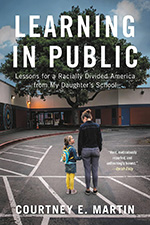Reviewed by Grace Brown
 For an entire page in this book the author repeats over and over: "Can we love one another's children?"
For an entire page in this book the author repeats over and over: "Can we love one another's children?"
The answer to this question is what the author is trying to answer in writing about her own experiences as a white mom sending her white kids to their locally zoned diverse Oakland neighborhood public school. This book, written in stories and streams of consciousness, is just a book of experiences. Through it, the author grapples (struggles) with her privilege, her choices, her decisions, her whys and hows. As the reader, we witness the author's love grow and expand for her neighborhood, her children's school, and ultimately, one another's children.
What action will you take as a result of reading this book?
I'd like to start a larger conversation around that same question of "Can we love one another's children?" Regardless of whether we have school-age children in our homes or not, this is an important question for all of us to wrestle with deeply. I think most of us would like to answer "yes" with our words, but our everyday actions and decisions often point to "no." As Christians called to love our neighbor as ourselves (Matthew 22:35-40), I hope we can encourage each other to be people who truly live out The Greatest Commandment in word and deed.
Is there anything else you'd like to share about this book?
This book, in the context of education, is another opportunity to "not look away" from unjust systems. You and me - we all live in neighborhoods with public schools. I'd like to know what we can do together to lovingly stand in the gap for all children, not just those in our own immediate families.
If you don't have time to read the book, check out one of these resources.
Where Are All the White Kids – In this 15-minute talk, Courtney Martin boils the essence of the book down to three important questions.
Learning in Public on The Integrated Schools Podcast (70 min) – Courtney Martin co-hosts this podcast episode which features an interview with Mrs. Minor, a key character in the book. She joins us to talk about the book along with one of the key characters from the book, Mrs. Minor. "After teaching Courtney's daughter, Mrs. Minor left the public school system to start her own private preschool, The Learning Forest. Courtney and Amha (as Mrs. Minor's new students call her) developed a friendship over the course of monthly conversations about integration, public education, race and more. Ahma brings a critical eye and nuanced perspective to the topic of integration, and pushes us to constantly reconsider if we are doing the right thing."
